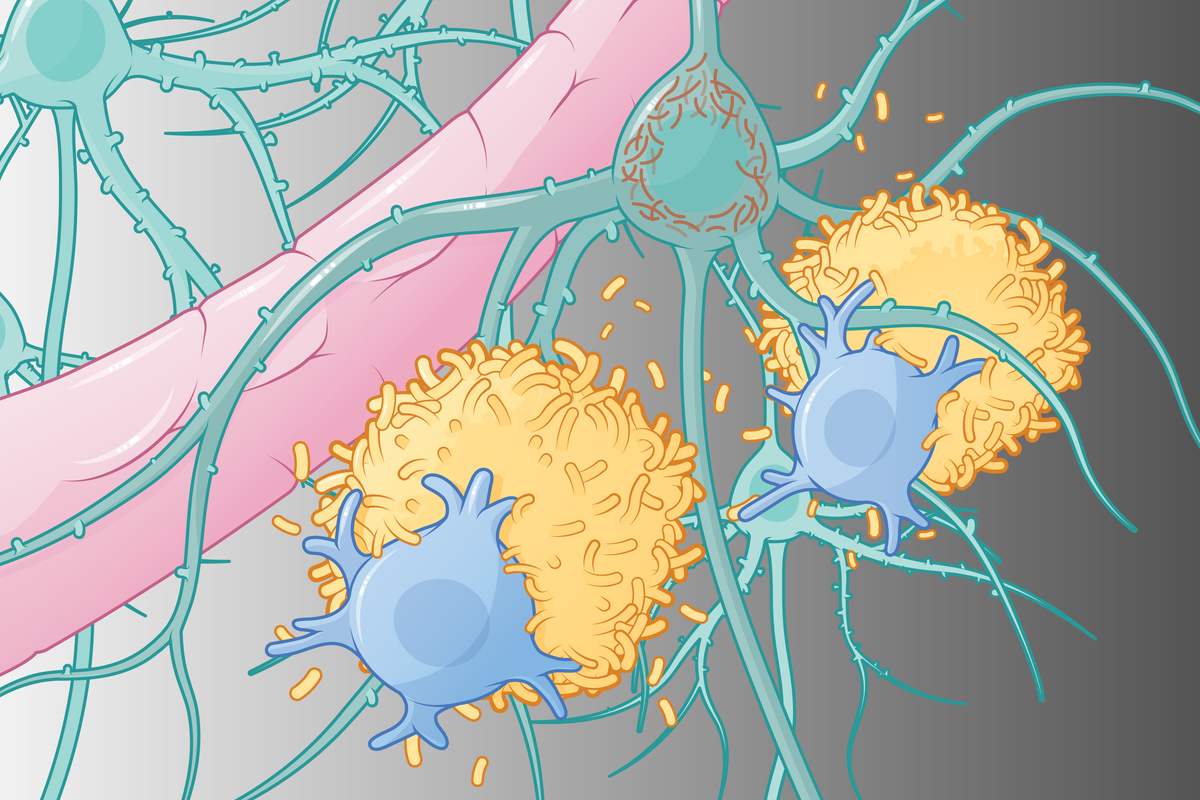
This article is part of “Innovations In: Alzheimer’s Disease” an editorially independent special report that was produced with financial support from Eisai.
Alzheimer’s disease has proved to be a tricky target, and researchers and drug developers have been pursuing effective treatments for decades. Debates rage over the disorder’s underlying causes, and various approaches have faced one hurdle after another. But the field has reached a turning point. Over the past four years the U.S. Food and Drug Administration has approved several therapies that address some of the condition’s potential biological roots rather than merely mitigating symptoms—a key scientific milestone. Despite the advances, however, there is still a long list of open questions and so much work to be done.
The brains of people who die with Alzheimer’s show a distinct biology: clumps or “plaques” of amyloid beta proteins in spaces between neurons and tangles of tau proteins that accumulate primarily within the nerve cells. One prevailing theory holds that amyloid builds up early, and tau tangles develop when nerve cell damage is underway but cognitive symptoms are not yet apparent. Over time these pathogenic, or disease-causing, proteins disrupt nerve cell communication. The newest treatments—lecanemab and donanemab—bind to amyloid beta proteins, clear them from the brain and modestly slow cognitive decline.
On supporting science journalism
If you’re enjoying this article, consider supporting our award-winning journalism by subscribing. By purchasing a subscription you are helping to ensure the future of impactful stories about the discoveries and ideas shaping our world today.
But the progression from disease-linked proteins to actual dementia is long and inexact, and amyloid and tau proteins accumulate in people with other neurodegenerative disorders, too. With Alzheimer’s there is often a 20- to 30-year lag between the initial detection of amyloid and obvious cognitive decline. According to one study that predicted disease risk based on demographic data, death rates and amyloid status, fewer than one quarter of cognitively healthy 75-year-old women who test positive for amyloid in a spinal fluid analysis or positron-emission tomography (PET) brain scan will develop Alzheimer’s dementia during their lifetime. Such findings suggest that amyloid alone is not driving disease progression and have spurred scientists to investigate other strategies.
DNA-sequencing analyses have identified gene variants that influence Alzheimer’s risk. Some of these genes point to a critical role of immune activity and inflammation in the disease process. Other research indicates that one way to reduce disease risk is through lifestyle changes. According to a 2024 report, nearly half of dementia cases worldwide could be prevented or delayed by actions addressing 14 modifiable risk factors, including hearing loss, physical inactivity, and vascular risk factors such as diabetes and smoking (many of which also impact immune activity and inflammation).
The Basics
A well-known hallmark of Alzheimer’s disease is the buildup of tau (a) and amyloid beta (b) proteins in the brain. Over time plaques and tangles cause neuron damage (c) and cell death. But most Alzheimer’s patients have accumulated other proteins, too, such as alpha-synuclein, as well as blood vessel damage that can appear before amyloid plaques. Recent evidence suggests that inflammation, immune processes and vascular risk factors also play a key role in the disease.
Treatment Targets
There are more than 100 ongoing clinical trials testing a variety of interventions, each of which targets one or more potential contributors to dementia. “We will get there in stages,” says Sudha Seshadri, a neurologist and founding director of the Glenn Biggs Institute for Alzheimer’s and Neurodegenerative Diseases at UT Health San Antonio in Texas. “The amyloid-lowering treatments are a piece of it. Immune-modulating drugs are probably going to be a piece of it,” she says. It will also be important to control for vascular risk, she adds, which “is important regardless of what else is happening.”
The mechanisms listed here are considered key elements of Alzheimer’s risk:
Neurotransmitter receptors • Proteins on nerve cell surfaces that receive signals and play a critical role in memory and learning. Some drugs for Alzheimer’s block harmful activity at these receptors, and others boost activity by preventing the breakdown of neurotransmitters.
Amyloid • A protein that, when misfolded, can build up outside of nerve cells in the brain and form plaques that disrupt neural function. Several therapies aim to dissolve these deposits.
Inflammation and immune processes • These can be activated by the buildup of abnormal forms of amyloid and tau in the brain, leading to nerve cell damage and cognitive decline.
Tau • A protein that typically helps to maintain a cell’s structure and shape. It can build up within neurons and form tangles, which are a hallmark of Alzheimer’s, along with amyloid plaques. Some new therapies attempt to target pathological forms of tau, preventing these proteins’ aggregation and enhancing their clearance.
Synaptic plasticity and neuroprotection • Ways in which the brain modifies connections between neurons during learning and memory and protects neurons from damage. Both processes can be disrupted in people with Alzheimer’s.
Metabolism • The process by which the brain breaks down nutrients. In Alzheimer’s patients, PET scans show abnormally low glucose metabolism in brain areas important for memory and cognition. Some therapies aim to increase the metabolism of glucose, which the brain needs for energy.
Vasculature • Specialized blood vessels in the brain form a dynamic interface known as the blood-brain barrier, which helps to supply nutrients to nerve cells and protect the brain from pathogens. Breakdown of this barrier has been associated with multiple neurodegenerative diseases, including Alzheimer’s.
Growth factors and hormones • Proteins that can protect brain cells from damage and stimulate the production of new cells. Some therapies aim to replenish them and provide an extra layer of protection.
Epigenetic regulators • Proteins and other molecules that turn a gene on or off without changing the underlying DNA sequence. In doing so, they can influence the accumulation of misfolded amyloid, misfolded tau, or other pathogenic proteins.
Neurogenesis • Neural growth. Damaged nerve cells can contribute to memory impairment and cognitive decline in people with Alzheimer’s. Promoting the growth of new nerve cells could help slow that decline.
Oxidative stress • An unhealthy overabundance of free radicals relative to antioxidants in the body, which can harm nerve cells and disrupt their function. Some therapies aim to relieve oxidative damage by enhancing the activity of specific enzymes that neutralize free radicals.
Proteostasis • A process that maintains proper protein folding, synthesis and degradation in cells and can become impaired in people with Alzheimer’s. Some experimental interventions promote cellular pathways that prevent misfolded proteins or that facilitate their removal.
APOE • Abbreviation for apolipoprotein E, a protein-encoding gene that has three major forms: ε2, ε3 and ε4. APOE ε4 is the strongest genetic risk factor for Alzheimer’s. People have two copies, or alleles, of APOE. Having one APOE ε4 allele can increase someone’s lifetime risk of disease up to fourfold over that of people with two copies of the most common variant, APOE ε3; two APOE ε4 alleles can raise the risk up to 25-fold. People with two APOE ε3 alleles are 40 percent more likely to develop Alzheimer’s than those with one ε3 and one ε2.
A Variety of Drug Approaches
This chart includes 138 drugs across 182 clinical trials—pharmacological Alzheimer’s trials registered with clinicaltrials.gov as of January 2025. Though not comprehensive (for example, not all trials based outside of the U.S. are included), the dataset provides a useful big-picture view. [Editor’s Note: Trials focused on exercise, lifestyle or caregiver interventions, cognitive behavioral therapies, supplements, medical foods or stem cell therapies are also not included.] Trials are grouped according to shared mechanism of action on the left (treatment targets) and therapeutic goals on the right. Pie charts show what percent of each category of drugs are in phase 1, phase 2 and phase 3 trials. (Drugs in phase 3 trials are generally closer to FDA approval than phase 1.) Neurotransmitter receptors, amyloid and inflammation are currently the most often targeted mechanisms. The most popular therapeutic category is disease-targeting drugs—in which the goal is to slow clinical decline by focusing on molecules and body systems. Symptom-targeting drugs, in contrast, aim to improve measurable symptoms that are already present at the start of the treatment.
Intervention Case Studies
While drugs that target the proteins amyloid and tau have garnered heavy attention and funding, other therapeutic approaches have focused on other biological mechanisms in Alzheimer’s disease. Examples of the latter group are described below.
Inflammation • Keeping nerve cells healthy and protecting them from damage requires balance between soluble and membrane-bound forms of a protein called TNF-α. In conditions of immune dysfunction, a rise in soluble TNF-α disrupts the healthy balance, or homeostasis, and drives up inflammation. One company (INmune Bio) is developing a drug that binds and deactivates soluble TNF-α, restoring health-promoting effects of the transmembrane form.
Metabolism • Insulin, a hormone that regulates energy availability and brain cell communication, also helps to maintain immune and vascular health. A clinical trial led by Suzanne Craft of the Wake Forest University School of Medicine is testing intranasal delivery of insulin and the diabetes drug empagliflozin in people with early Alzheimer’s or mild cognitive impairment.
Vasculature • Several companies are developing new versions of amyloid antibodies that can penetrate the brain more effectively—for instance, Roche’s trontinemab. At least one company, Neuvasq, is developing an earlier-stage intervention that targets the vasculature itself, to test whether a less leaky blood-brain barrier could slow disease progression.



